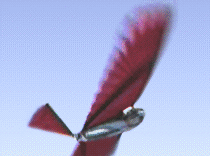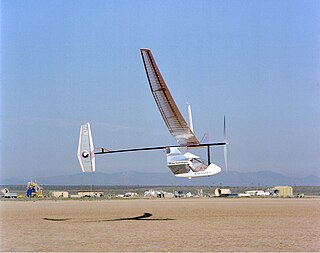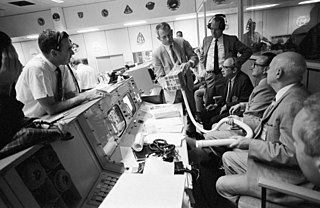Related Research Articles

Human-powered transport is the transport of person(s) and/or goods (freight) using human muscle power. Unlike animal-powered transport, human-powered transport has existed since time immemorial in the form of walking, running and swimming, as well as small vehicles such as litters, rickshaws, wheelchairs and wheelbarrows. Modern technology has allowed mechanical advantage devices and machines to enhance human-power.

The Gossamer Albatross is a human-powered aircraft built by American aeronautical engineer Dr Paul B MacCready's company AeroVironment. On June 12, 1979, it completed a successful crossing of the English Channel to win the second Kremer prize worth £100,000.

An ornithopter is an aircraft that flies by flapping its wings. Designers sought to imitate the flapping-wing flight of birds, bats, and insects. Though machines may differ in form, they are usually built on the same scale as flying animals. Larger, crewed ornithopters have also been built and some have been successful. Crewed ornithopters are generally powered either by engines or by the pilot.

The MacCready Gossamer Condor was the first human-powered aircraft capable of controlled and sustained flight; as such, it won the Kremer prize in 1977. Its design was led by Paul MacCready of AeroVironment, Inc.

The Royal Aeronautical Society, also known as the RAeS, is a British multi-disciplinary professional institution dedicated to the global aerospace community. Founded in 1866, it is the oldest aeronautical society in the world. Members, Fellows, and Companions of the society can use the post-nominal letters MRAeS, FRAeS, or CRAeS, respectively.

The MIT Aeronautics and Astronautics Department's Daedalus is a class of three human-powered aircraft that included Daedalus 88 – which, on 23 April 1988, flew a distance of 115.11 kilometres (71.53 mi) in 3 hours, 54 minutes, from Heraklion on the island of Crete to the island of Santorini. The flight holds official FAI world records for total distance, straight-line distance, and duration for human-powered aircraft.
The Kremer prizes are a series of monetary awards, established in 1959 by the industrialist Henry Kremer.

Paul B. MacCready Jr. was an American aeronautical engineer. He was the founder of AeroVironment and the designer of the human-powered aircraft that won the first Kremer prize. He devoted his life to developing more efficient transportation vehicles that could "do more with less".

MoD Boscombe Down(ICAO: EGDM) is the home of a military aircraft testing site, on the south-eastern outskirts of the town of Amesbury, Wiltshire, England. The site is managed by QinetiQ, the private defence company created as part of the breakup of the Defence Evaluation and Research Agency (DERA) in 2001 by the UK Ministry of Defence (MoD).
Dr. Imraan Faruque is an American who is most known as a designer and author in the unmanned aerial vehicle (UAV) field. He is the designer responsible for a variety of UAVs, including several currently operational in Iraq, the most well-known being the R-series UAVs which are based on commercial airframes, along with work on Insitu's ScanEagle. These vehicles are normally deployed as a part of reconnaissance missions as they are unarmed but carry either a significant camera or FLIR unit.

The Pedaliante was a human-powered aircraft designed and built by Enea Bossi and Vittorio Bonomi and credited with, in 1936, making one of the first fully human-powered flights. The aircraft successfully traveled 1 km (0.62 mi) as part of an Italian competition, but was denied the monetary prize due to its catapult launch.

Aerospace engineering is the primary field of engineering concerned with the development of aircraft and spacecraft. It has two major and overlapping branches: aeronautical engineering and astronautical engineering. Avionics engineering is similar, but deals with the electronics side of aerospace engineering.

A human-powered aircraft (HPA) is an aircraft belonging to the class of vehicles known as human-powered transport.

James E. Brown III is an aerospace executive, test pilot instructor, and former United States Air Force officer. As of 2021, he is the president of the National Test Pilot School located in Mojave, California.

The Southampton University Man Powered Aircraft on 9 November 1961 became the first human-powered aeroplane to make an officially authenticated take-off and flight. It was designed and built by Southampton university students between 1960 and 1961 for an attempt at the Kremer prize, but it was never able to complete the 'figure-of-eight' course specified to claim the prize money.

The University of Maryland Gamera I is a human-powered helicopter designed to win the $250,000 Sikorsky Prize.
The University of Maryland Gamera II is an improved human-powered helicopter designed to win the US$250,000 Sikorsky Prize.
Airglow is a pedal-driven human-powered aircraft. It was designed and developed by brothers John and Mark McIntyre of Cambridgeshire, England.
John Wimpenny was an English aeronautical engineer who held the record for the longest human powered flight.
The Goodhart Newbury Manflier was a two-place human-powered aircraft designed by Nicholas Goodhart. Its most notable feature was that the two pilots were placed in separate fuselages, spaced 70 ft apart.
References
- ↑ "Human Powered Aircraft Group Webpage". Royal Aeronautical Society. 21 May 2006. Archived from the original on 24 April 2007. Retrieved 21 May 2007.
- ↑ "Human Powered Flight" . Retrieved 18 January 2021.
- ↑ "Human Powered Aircraft Group at Virginia Tech webpage". Virginia Tech. 21 May 2006. Archived from the original on 8 February 2007. Retrieved 21 May 2007.